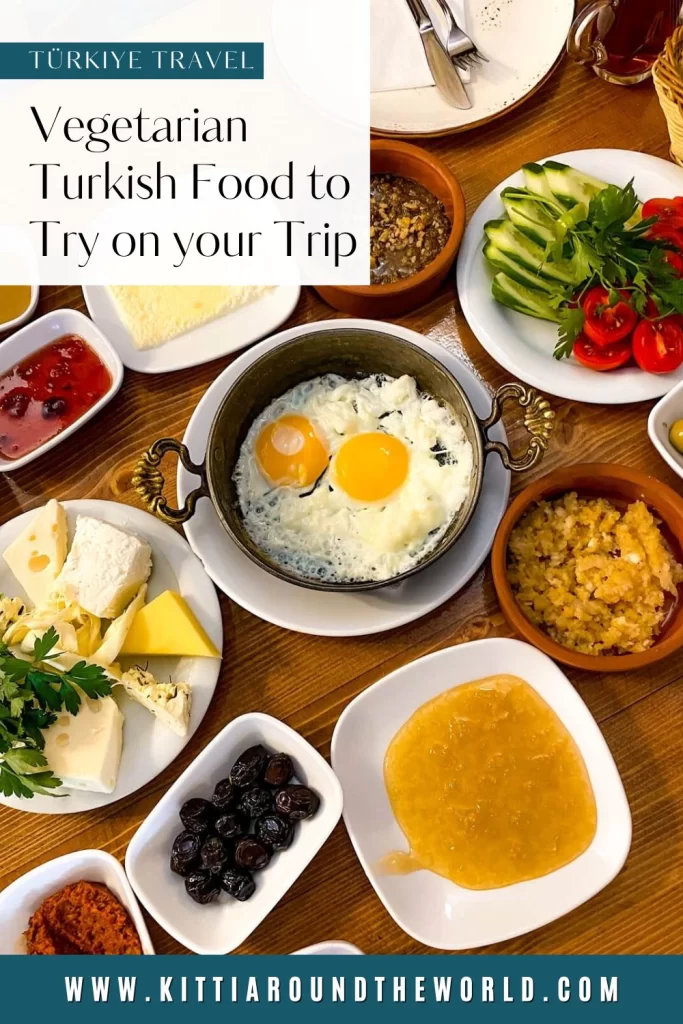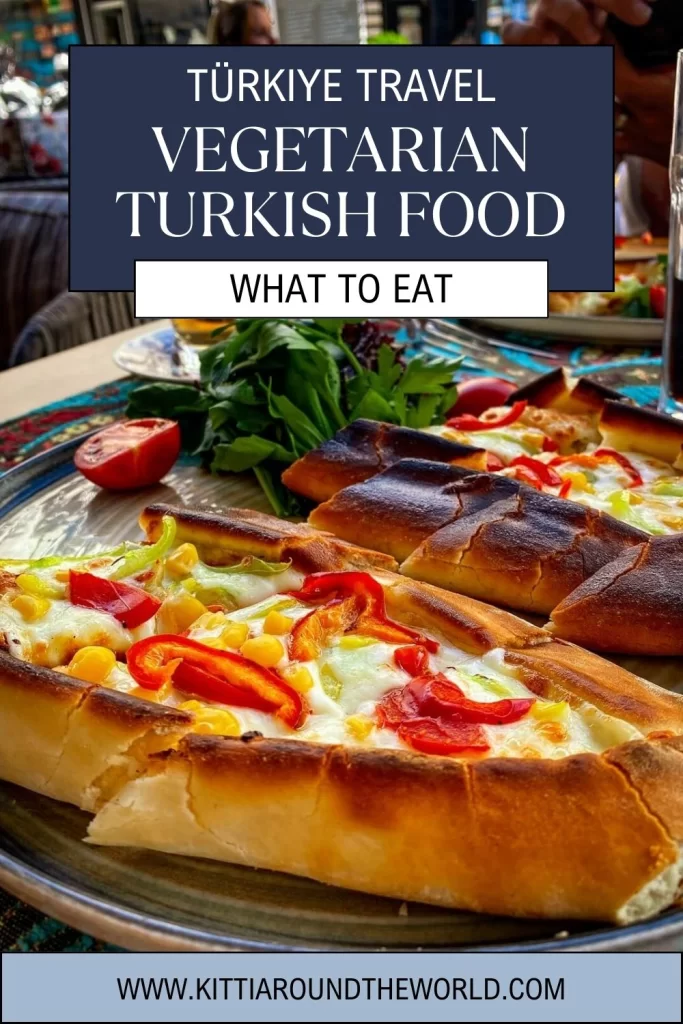Vegetarian Turkish Food to Try on Your Trip to Türkiye
When it comes to Turkish food, many people immediately think of some of the most popular meat-based dishes, such as the döner kebab. However, Turkish cuisine also has a wide array of vegetarian foods thanks to the country’s rich culture, history and geography.
We spent about six weeks in Türkiye, and never once felt like we couldn’t enjoy the local cuisine because of our diets. So, in this short guide, we’ve decided to share some of our favourite vegetarian Turkish foods that you should also try during your visit to the country.
Disclosure: This post may contain affiliate links, which means we may receive a small commission if you click a link and purchase something. Clicking these links won’t cost you anything, but it will help us to keep this site up and running! Learn more about our affiliate policy.

About Turkish Food
Today’s Turkish cuisine is a unique blend of different flavours, spices and herbs, which has developed over thousands of years. Their food has been influenced by the country’s history, culture and geographical location, which has created a huge variety in the types of dishes you can taste during your visit. There are definitely similarities to the cuisines of Central Asia, the Middle East, and the Mediterranean.
If you’re a vegetarian like us, then you’ll be pleased to know that some of the main ingredients in Turkish food include aubergine, legumes such as chickpeas and lentils, tomatoes, and peppers. To give the dishes an amazing flavour they use a variety of spices like cumin, coriander, chili flakes, and paprika. Many of the ingredients, herbs and spices are known for their health benefits, so you really can’t go wrong eating in Türkiye. Well, perhaps only by over indulging in their sweet treats, which is all to easy to do, trust us!
Our Favourite Sites to Find Food Tours in Türkiye:
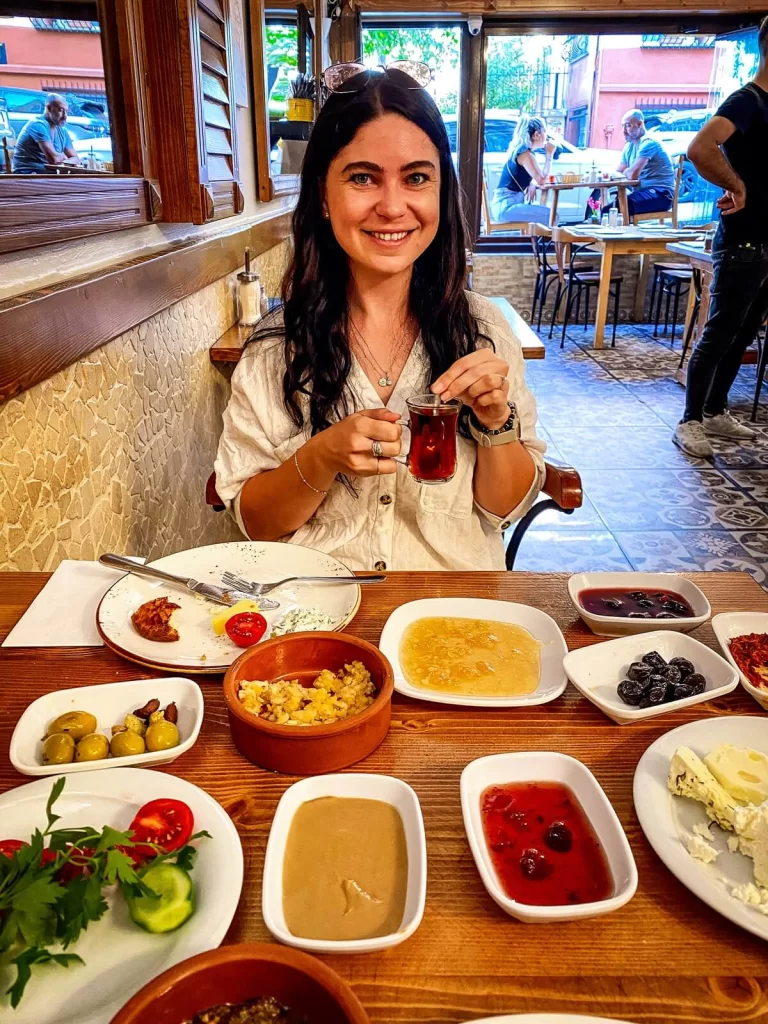
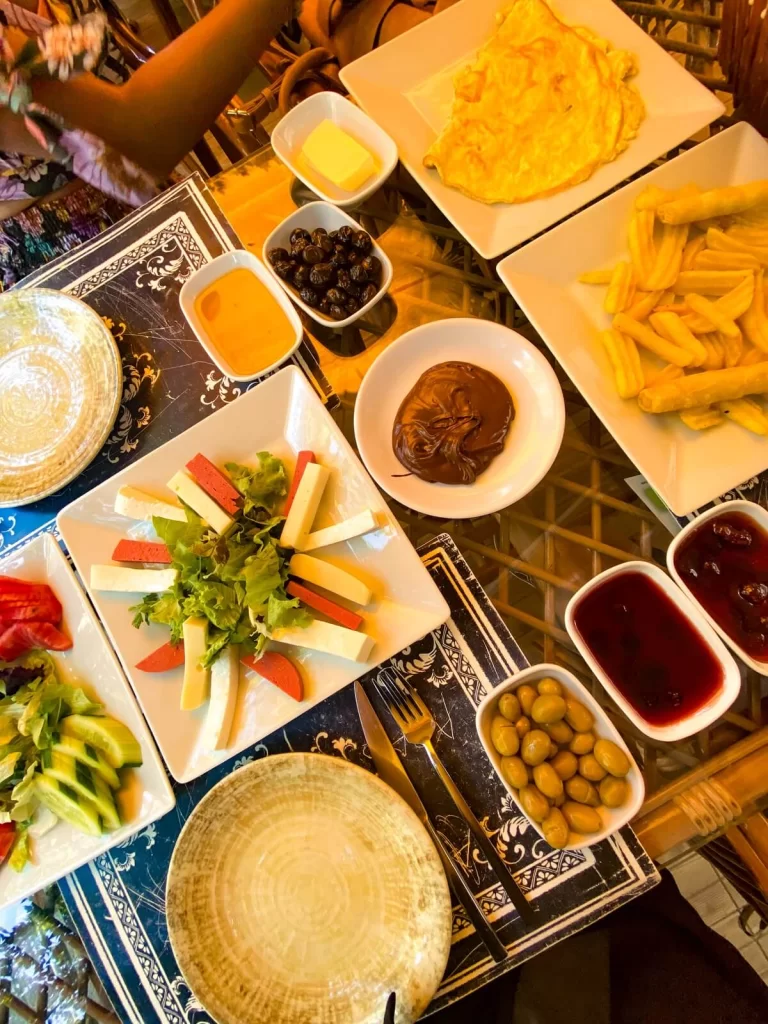
Vegetarian Turkish Foods to Try in Türkiye
The following dishes are available pretty much anywhere in the country, however you may notice some regional differences as you eat your way through Türkiye. Of course, it’s worth highlighting that there are way more options when it comes to Turkish vegetarian food than what we’ve included here. Our list is just a small sample of the huge selection of meals you can try, so make sure to check the menu for other veggie alternatives.
Top Tip. We found that the best way to learn more about Turkish cuisine is by joining a dedicated food tour.
Turkish Breakfast (Kahvalti)
Some say that breakfast is the most important meal of the day. Well, it’s definitely true in Türkiye because they don’t do their breakfast in half measures. Also known as ‘kahvalti’, a classic Turkish breakfast includes a variety of sweet and savoury bite-sized foods that will set you up well for the day.
Normally, when we ordered a Turkish breakfast they gave us eggs, cheese, black and green olives, tomatoes, cucumbers, sauces, fresh bread, jams, honey, and pastries. We did notice that there were regional differences as we traveled around, so it’s worth double checking if a breakfast includes any meat before ordering. Of course, it wouldn’t be a traditional Turkish breakfast without an unlimited supply of black tea (Çay).
One thing’s for sure: there wasn’t much room on the table after they’d finished bringing everything out, and their won’t be any room in your stomach afterwards. After a Turkish breakfast, we were full almost until dinner time. There are endless places you can enjoy this typically vegetarian Turkish meal across the country.
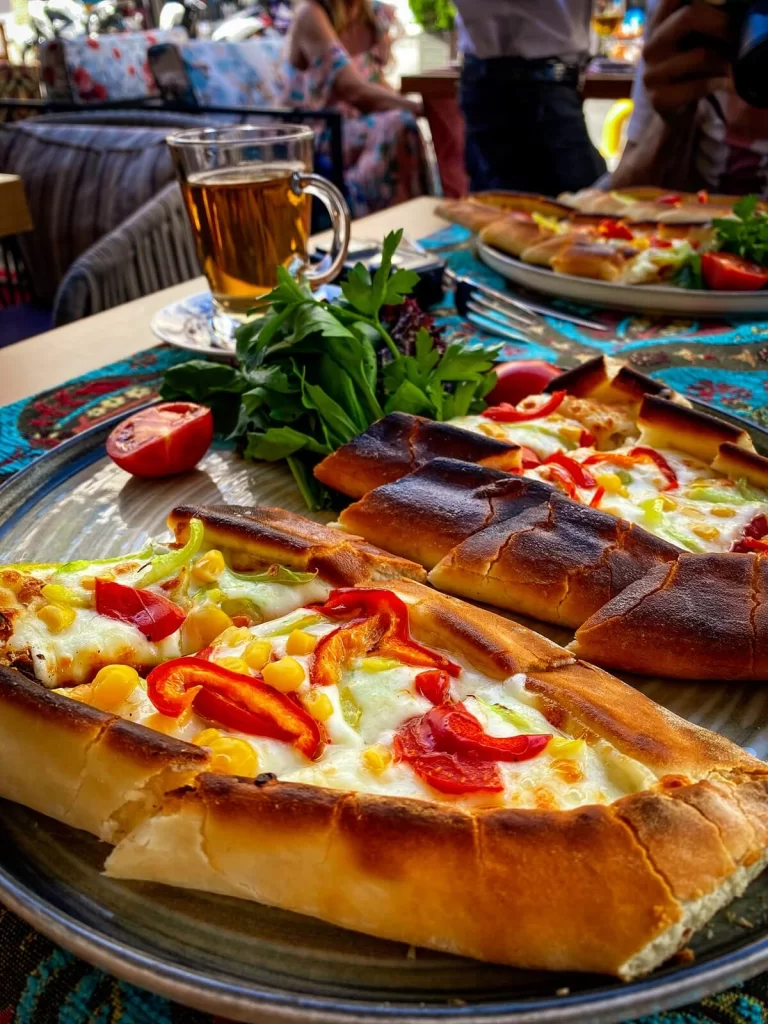
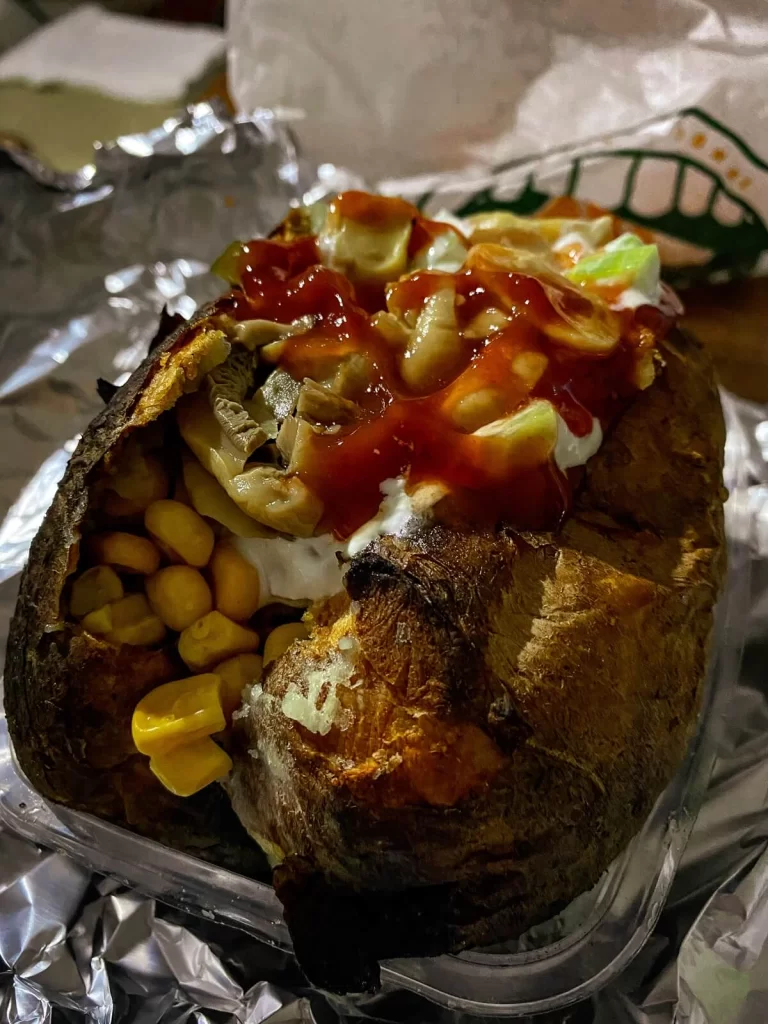
Pide (the Turkish ‘Pizza’)
Pide is a boat-shaped Turkish flatbread which is often referred to as a Turkish ‘pizza’. The similarity to pizza comes from the thick dough and variety of toppings you can have with it, rather than the shape. Although many enjoy them with a selection of meats, we found you could order ones with just vegetables and cheese, which makes pide a great vegetarian Turkish food.
You can eat pide anywhere in the country, as they serve it in both fast food joints and sit-down restaurants. It was definitely our go-to, quick-bite lunch option, especially after a hearty traditional breakfast.
Kumpir
Street food is an important part of Türkiye’s food culture. One of our favourite go-to street foods, especially in Istanbul, was Kumpir.
Kumpir is basically a huge jacket potato, or baked potato, cut in half. They’ll normally put butter and cheese inside as a base. Then, you can load it with a huge variety of fillings such as salads, pickles, mushrooms, olives, corn; you name it. Since it’s completely your choice what goes into your jacket potato, it’s a fantastic, and very filling, food option if you’re vegetarian.
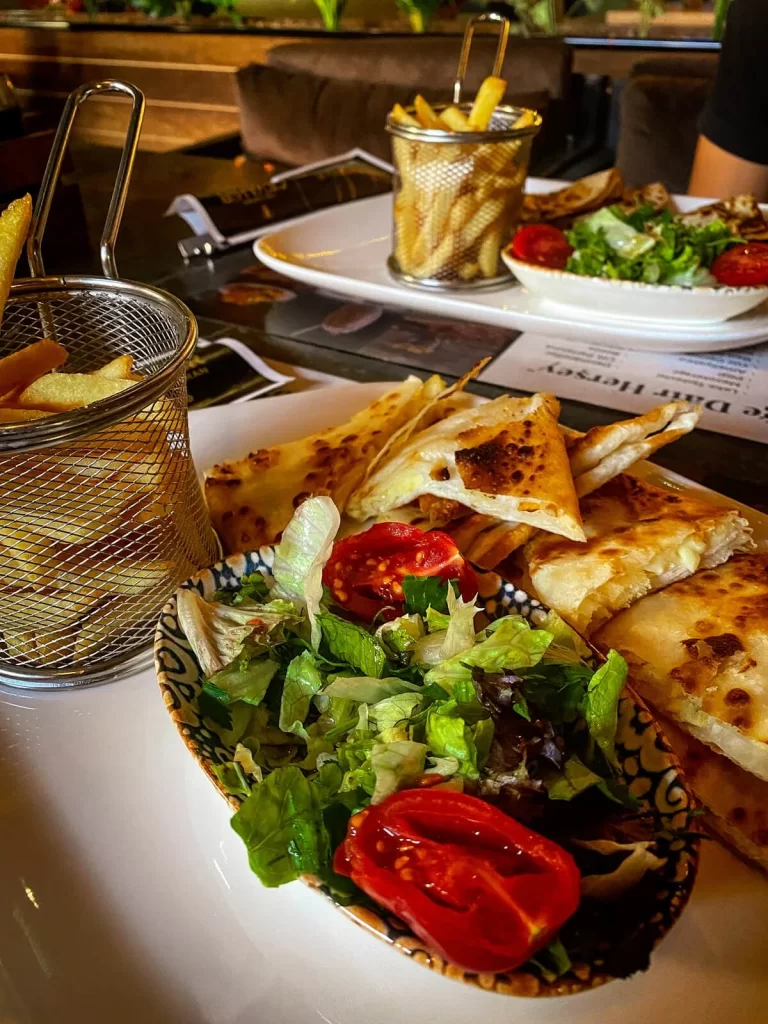
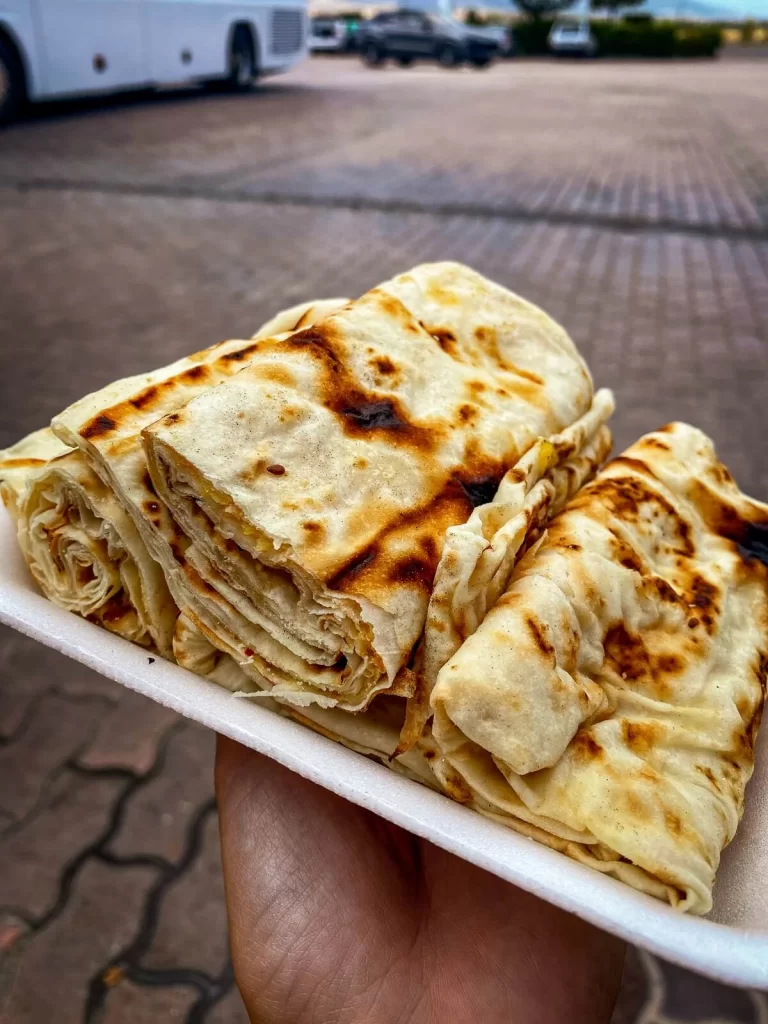
Gözleme
Also known as the Turkish ‘pancake’, gözleme is a simple but delicious Turkish street food you can eat if you’re vegetarian.
First, they roll the unleavened dough very thinly. Then, they put the fillings in before sealing and cooking them on a big round sac griddle. Luckily, there are a variety of savoury filling options for vegetarians such as potato, cheese, mushroom, and spinach.
Again, you can find gözleme anywhere in Türkiye, from street-vendors to cafes. It was our favourite snack to grab during bus journey breaks. We also loved watching them being prepared right in front of us. You can’t get any fresher than that!
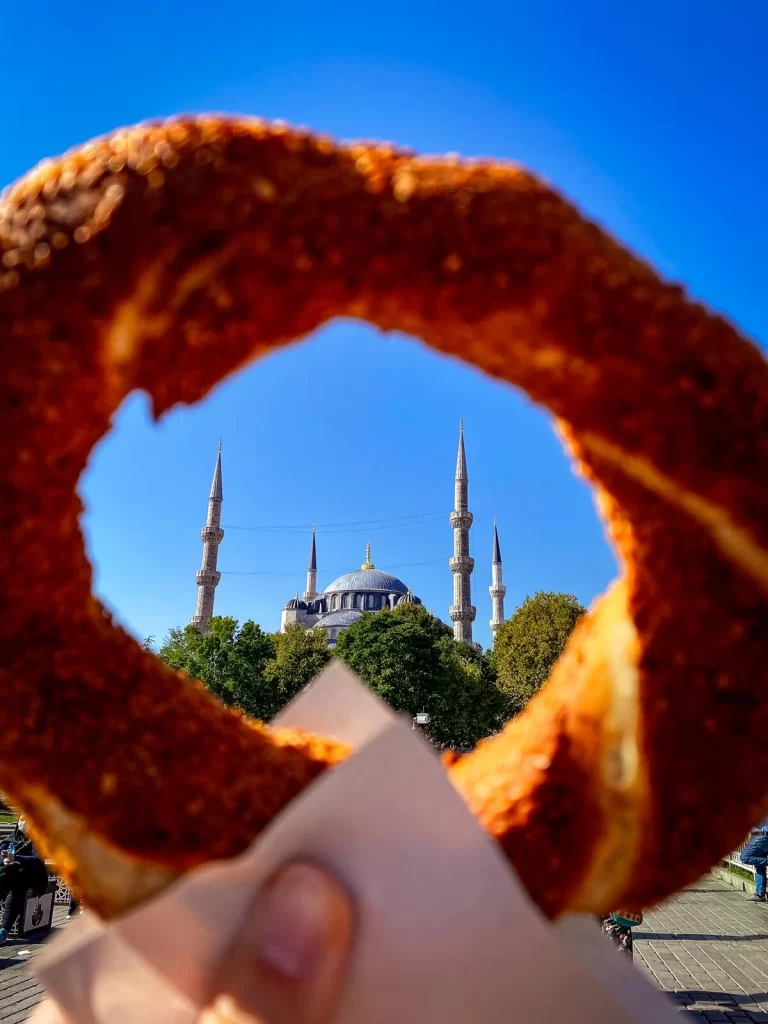
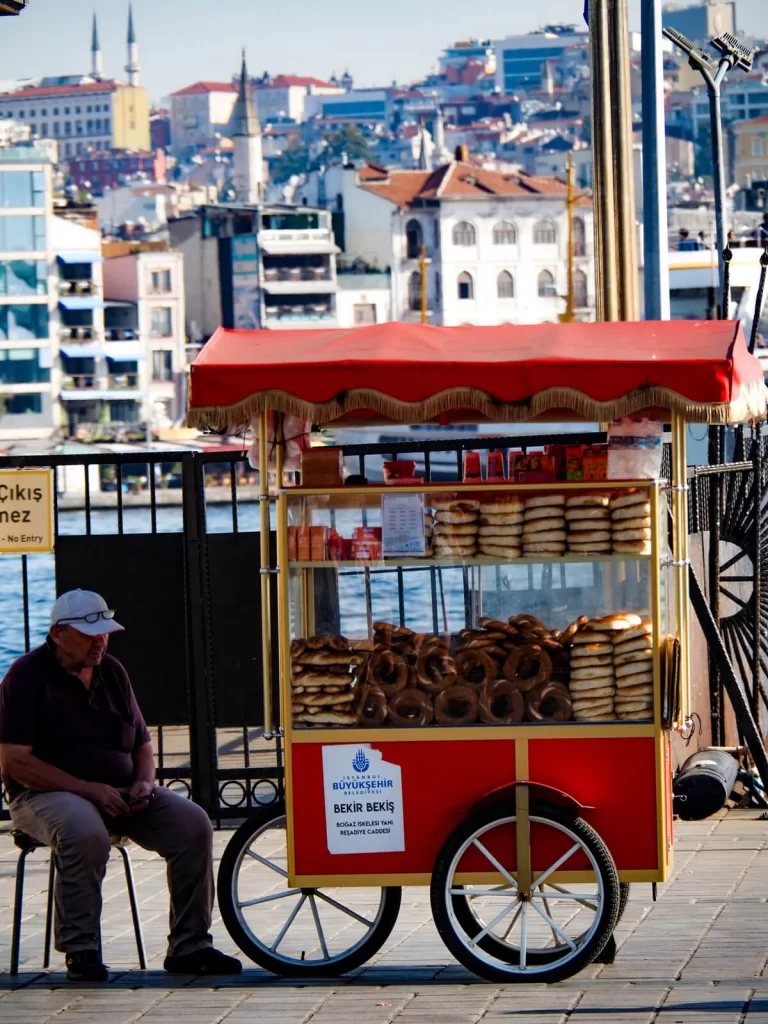
Simit
Hands down, the most popular Turkish street food has to be simit. It’s essentially a delicious, ring-shaped bread covered in sesame seeds. You can’t walk anywhere in Türkiye without seeing them piled up in red street food carts.
The best part is that you can just consume Simit on their own as a snack. We saw many people grabbing one on the go, so of course we did the same when we got a bit peckish. However, we also saw them served as part of a traditional breakfast. Simit goes very well with some cheese, or sweet spreads and jams. We normally washed them down with some Ayran or Turkish tea. They are one of those street foods that we keep wishing we could eat more of back home too.
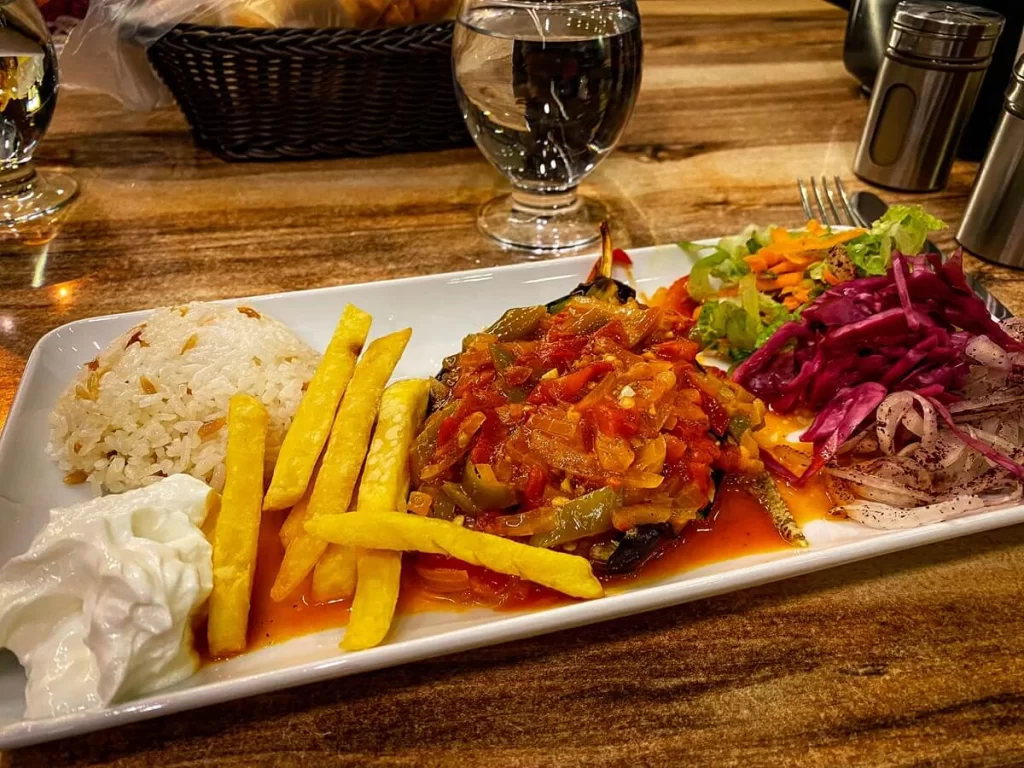
Imam Bayildi (Stuffed Aubergines)
Imam Bayildi is possibly the tastiest vegetarian Turkish food. We might be a bit biased because we love aubergines and enjoyed a similar dish during our time in Albania. So, we couldn’t wait to have them again in Türkiye.
The dish is essentially a whole aubergine that’s been roasted and stuffed with a mix of onion, garlic, and tomato. You can eat it on its own, or with other small dishes, which is what we really love about Turkish food.
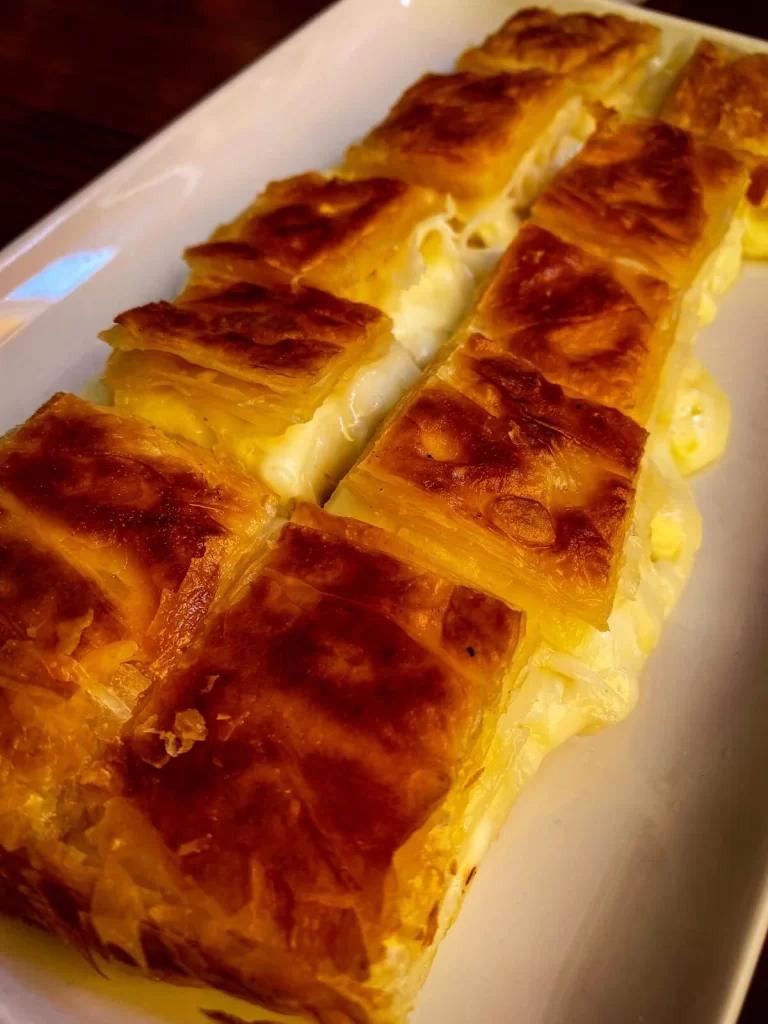
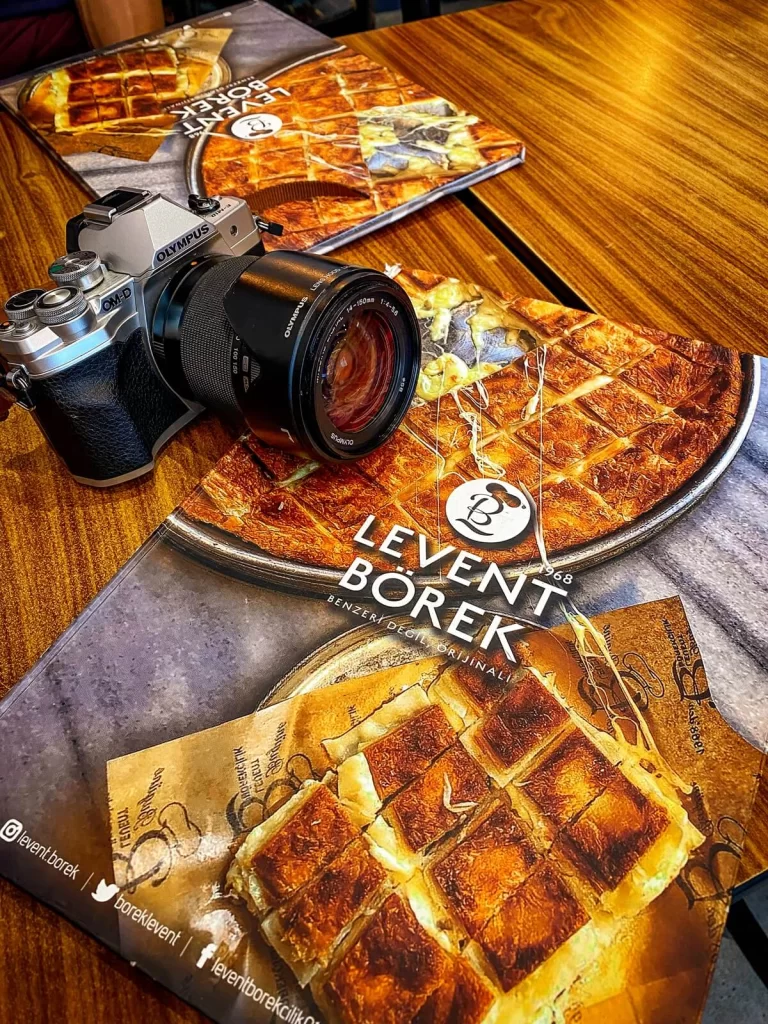
Börek
Another simple but delicious vegetarian friendly Turkish food is Börek. It’s basically stuffed pastry made with thin flaky dough. You can try börek with numerous fillings such as spinach, potatoes, mushrooms and other vegetables. However, the most popular filling is definitely cheese, which was our favourite variety too.
You can eat it as a quick snack, or combine it with other small dishes if you need something more substantial.
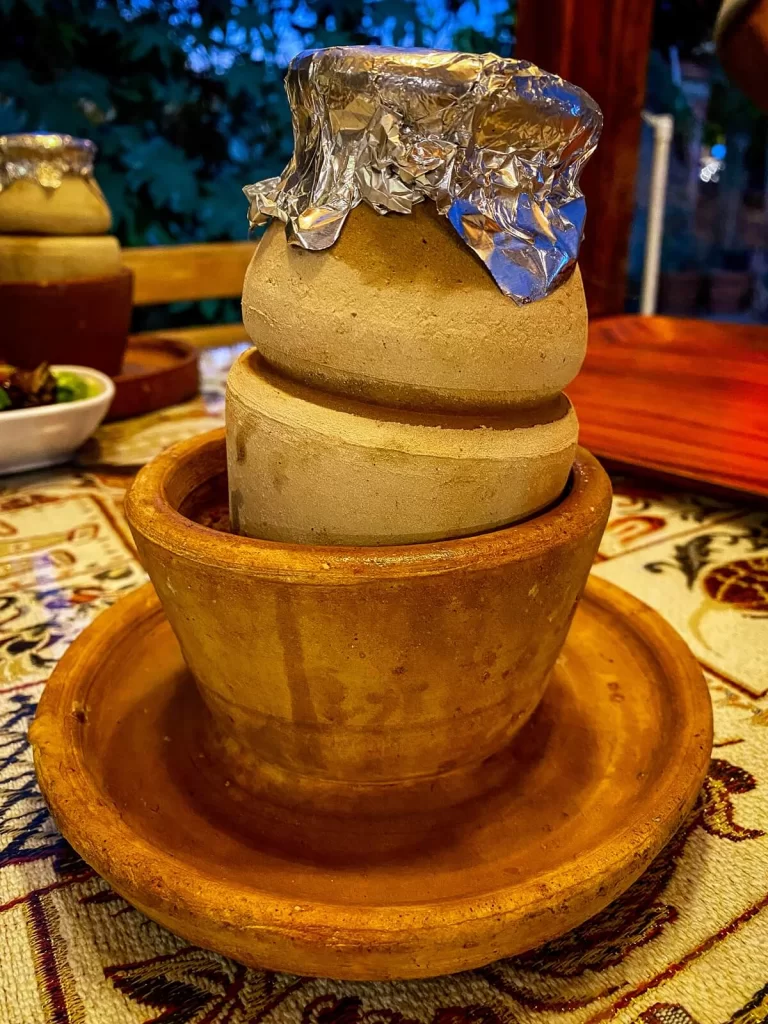
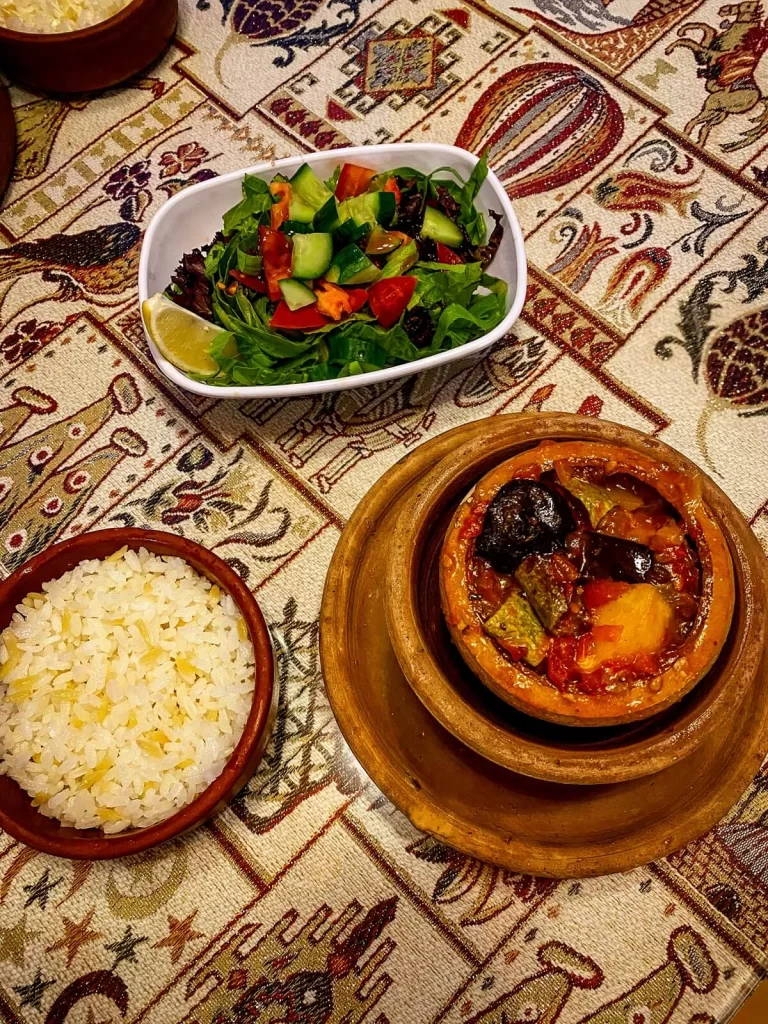
Pottery Kebab (Testi Kebab)
If you’re heading to Cappadocia to take an unforgettable hot air balloon flight, then definitely try the area’s specialty: testi kebab.
This Anatolian dish is cooked in a sealed clay pot for hours, so you’re guaranteed a flavourful meal. Whilst you can try a meat-based pottery kebab, we loved the fact that we could also enjoy a vegetarian version of this Turkish classic. It’s not just super delicious, but once it’s ready, they crack open the pot right in front of you, which really adds to the whole experience.
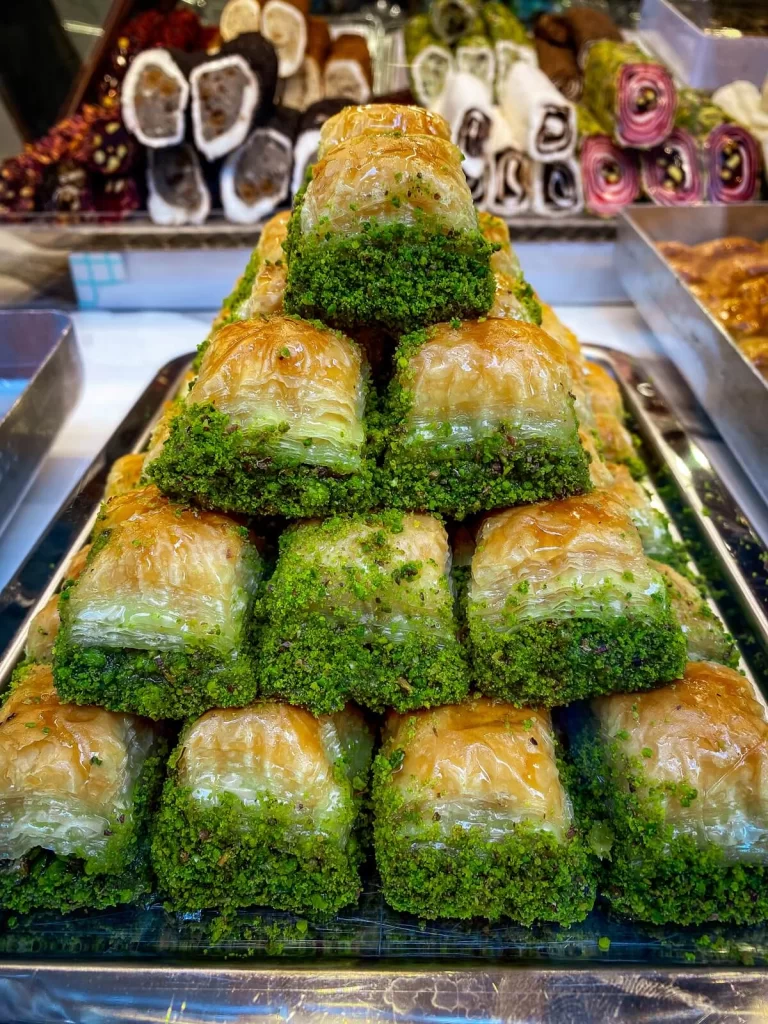

Turkish Sweet Treats to Try
If you’ve got a sweet-tooth like us, then you’ll love your time in Türkiye because there’s definitely no shortage of Turkish desserts to try. You can roughly divide Turkish sweet-treats into three categories: syrup based, milk-based and fruity desserts.
Below we’ve listed a few very well-known ones, as well as a couple of lesser-known but just as delicious treats.
Baklava
No Turkish food guide would be complete without mentioning Baklava. It’s a very rich, sweet dessert made with layers of pastry, filled with chopped nuts and drizzled with syrup.
Baklavas are super delicious, but we found you didn’t need many to feel completely full. We definitely overestimated how much we could eat the first time around. Some restaurants actually served a few complimentary pieces with our Turkish tea at the end of the meal. You can also try Baklava literally anywhere in the country, from pastry shops to the bazaars.

Turkish Delight (Lokum)
Another popular dessert that everybody knows about is Turkish Delight, or Lokum. They’re made with starch and sugar, and have different flavourings such as rosewater, orange and lemon. There are also many versions now enhanced with chopped pistachios, hazelnuts, walnuts and dates. They’re delicious but, again, we really couldn’t eat too much before feeling full and a bit sick! Often, we got served some complimentary Lokum when we ordered a Turkish coffee.
Turkish Delight is also one of the most popular souvenirs, thanks to their long shelf-life. Which is why we saw them piled up to the roof in pretty much every sweet shop and bazaar. If you’re wondering; yes, we did bring home a decent amount of Turkish Delight to share with our families.
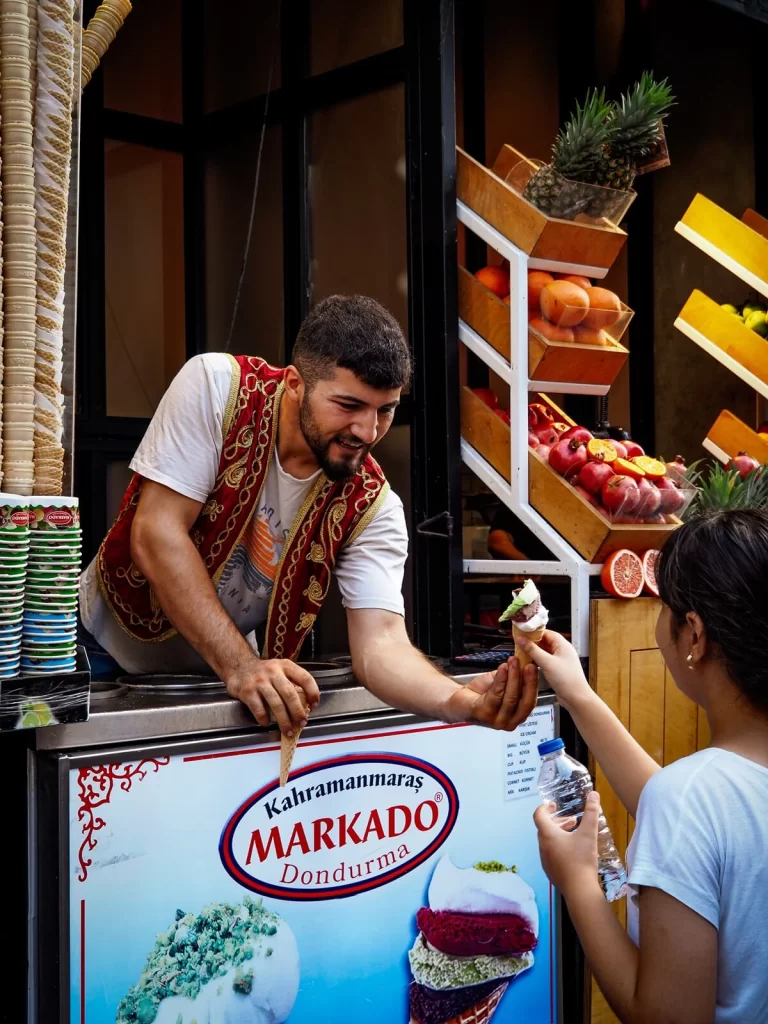
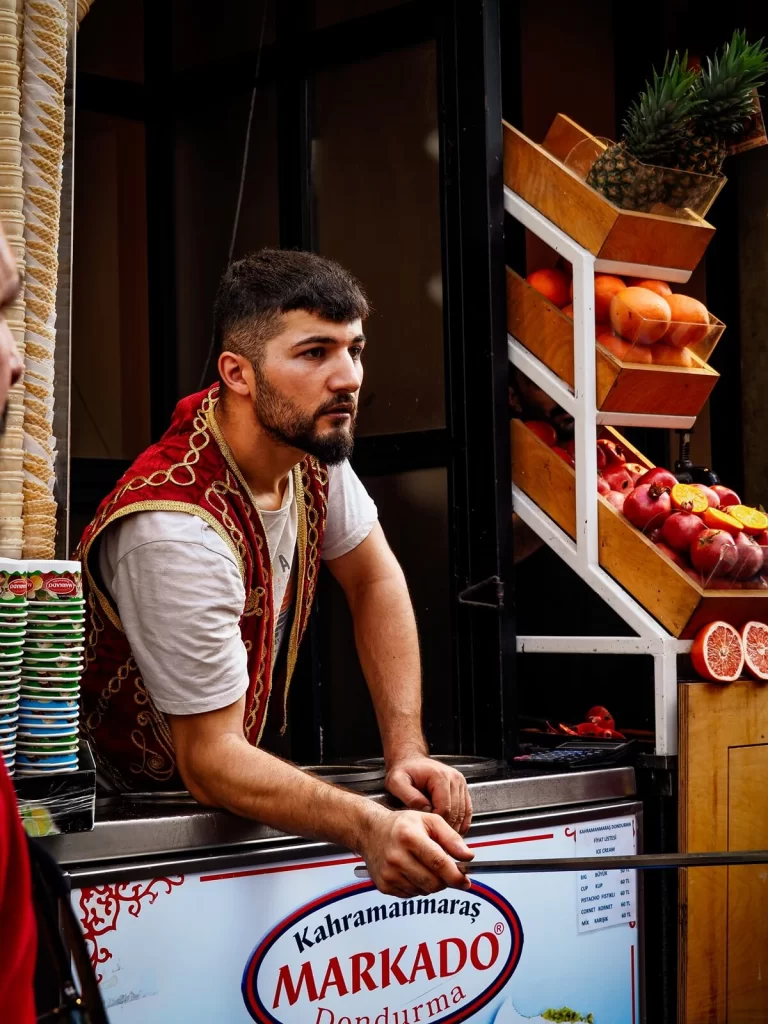
Turkish Ice Cream (Dondurma)
If you’re visiting Türkiye you have to try some delicious Turkish ice cream, or dondurma. It’s definitely not your typical Italian gelato, or even the never melting ‘ice cream’ we tried in Cuenca, Ecuador. However, it doesn’t melt too easily and looks a bit like the western ice cream you’ll be familiar with.
Traditional Turkish ice cream is thick and chewy, and it has a stretchy texture. This is due to one of the main ingredients used to make it: salep (root of the wild orchid).
Now, buying Turkish ice cream can be just as much fun as eating it. You can spot Turkish ice cream sellers anywhere because they’re dressed in traditional outfits and there’s always a big crowd surrounding them. The reason for the crowd and laughter is because they perform some cool tricks with the ice cream before you’re finally allowed to sample it.
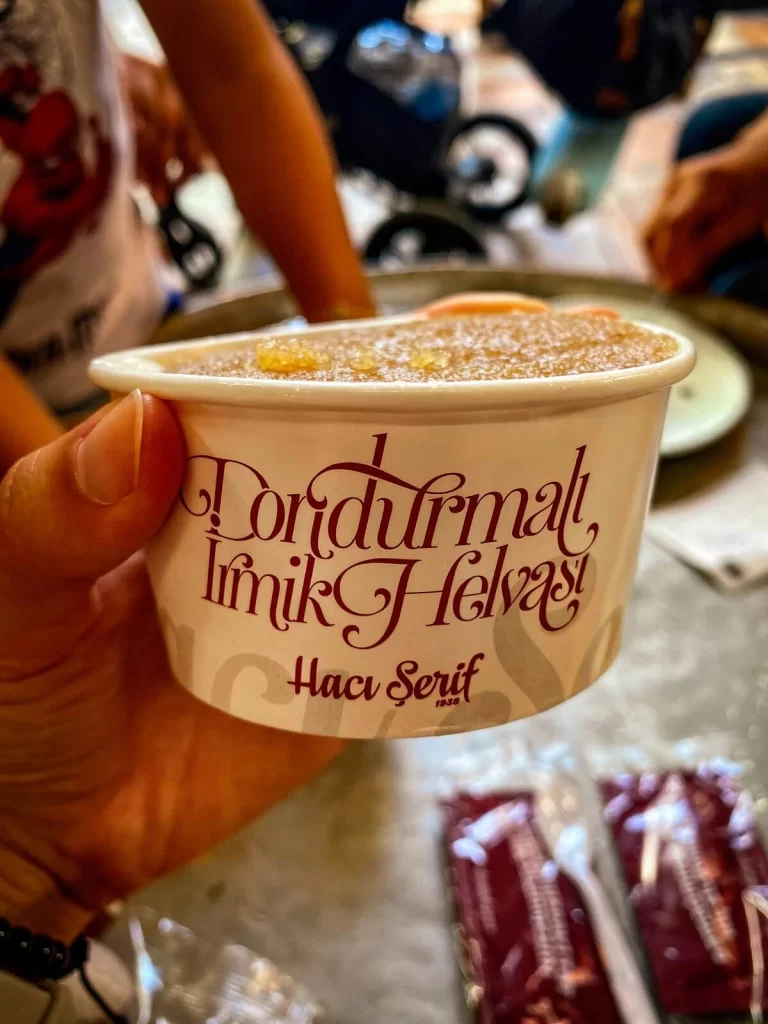
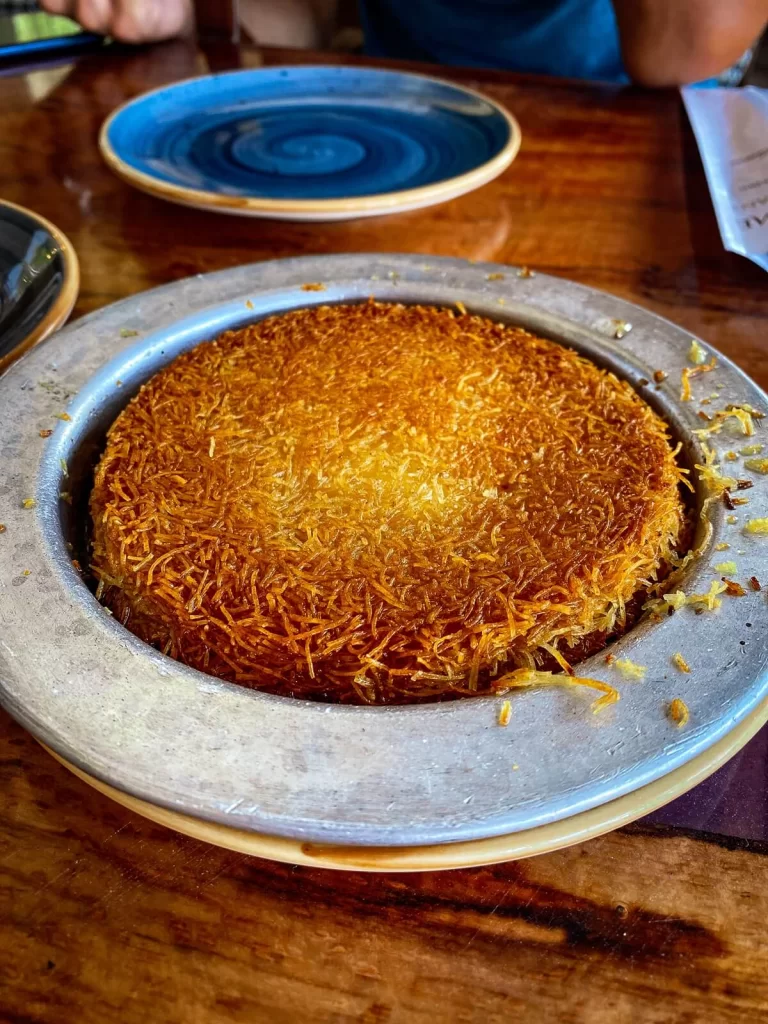
Semolina Halva with Ice-Cream (Dondurmali Irmik Helvasi)
Sticking with the ice-cream theme, another fun and light dessert we tried in Türkiye was semolina halva with ice-cream. It’s made with only a few ingredients, but is super delicious and definitely not as heavy as some of the other syrup based treats.
Künefe
Something we hadn’t heard as much about as Baklava and Turkish Delight before coming to Türkiye, was Künefe. However, it quickly became our favourite Turkish dessert.
It’s a crispy, cheese-filled sweet treat made with kadayif dough and drizzled with syrup. Künefe is cooked and served in a very shallow and round pan, that’s specially designed for making this dessert. It’s served hot, so the cheese is soft and stringy.
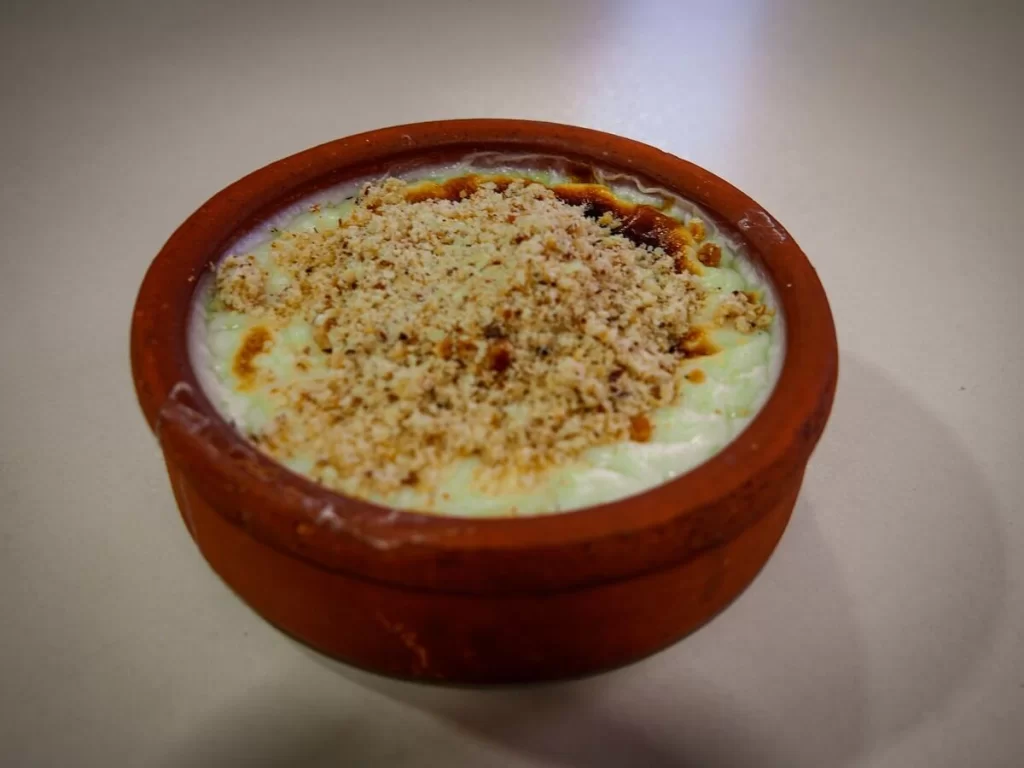
Turkish Rice Pudding (Sütlaç)
Sütlac, or Turkish rice pudding, is a popular milk-based dessert that’s definitely lighter than some of the more syrup based ones. As the name suggests, it’s essentially a rice pudding made of milk, rice and sugar.
Most of the time, we had baked rice puddings (fırın sütlaç), which are baked in the oven until the top is golden brown.
Halka Tatlisi (Turkish Churros)
A great grab and go sweet treat are Halka Tatlisi, or Turkish Churros. They’re made of yeasty dough that’s shaped into a ring, deep-fried and then soaked in sugary syrup. Again, we didn’t need many to make us full. We saw street food vendors selling them across the country, especially in Istanbul.
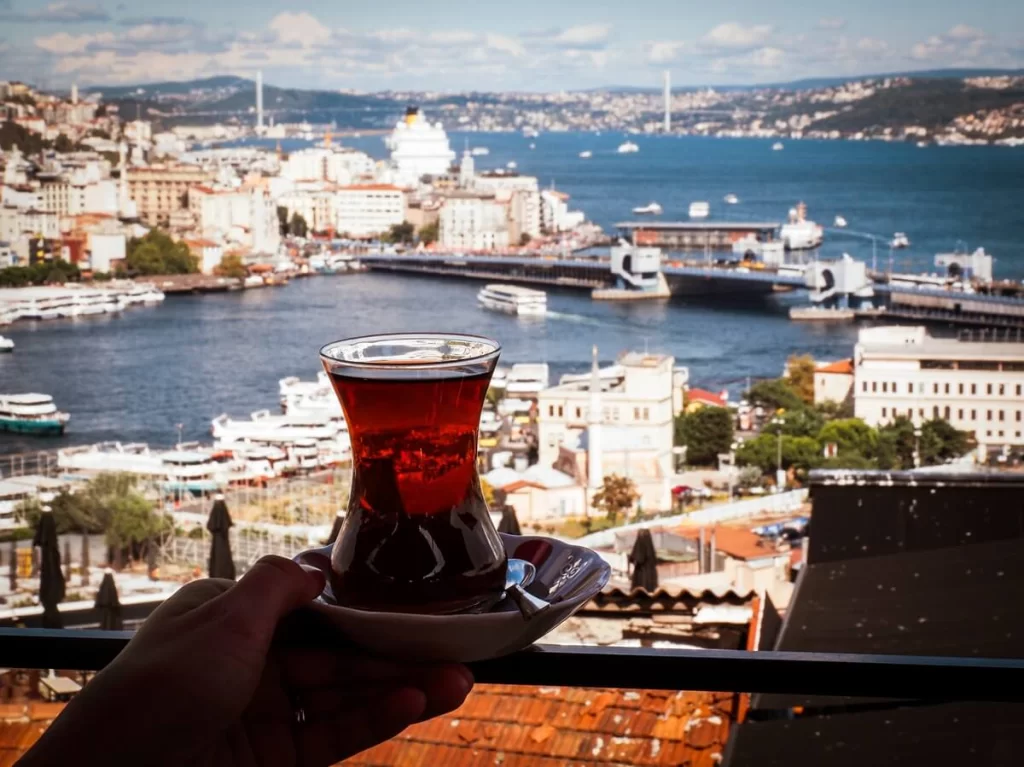


Best Drinks to Try in Turkey (Türkiye)
Our Turkish food guide wouldn’t be complete without mentioning some very popular beverages.
Turkish Tea (Çay)
Have you even been to Türkiye if you haven’t had some Turkish tea?
If this is your first time in the country, then you’ll quickly notice that Turks do love their tea. So much so that Türkiye is the largest consumer of tea in the world, followed closely by Ireland and the United Kingdom.
Unlike in most countries, you’ll mainly see the tea poured into small glass cups instead of mugs. The tea cups must be a popular gift to buy, because we saw plenty of tea glass sets on sale at various bazaars.
Tea is always offered to visitors and guests, and most restaurants also serve complimentary tea after meals. A number of times, we even got offered tea and stayed for a chat with the street food vendors. Bus attendants also served us tea on long-haul buses.
Top Tip. Whether you’re on a city break in Istanbul, going on a hot air balloon ride in Cappadocia, or wandering the narrow streets of Mardin, we recommend having a little tea break on a rooftop bar, or at a cafe with a view.
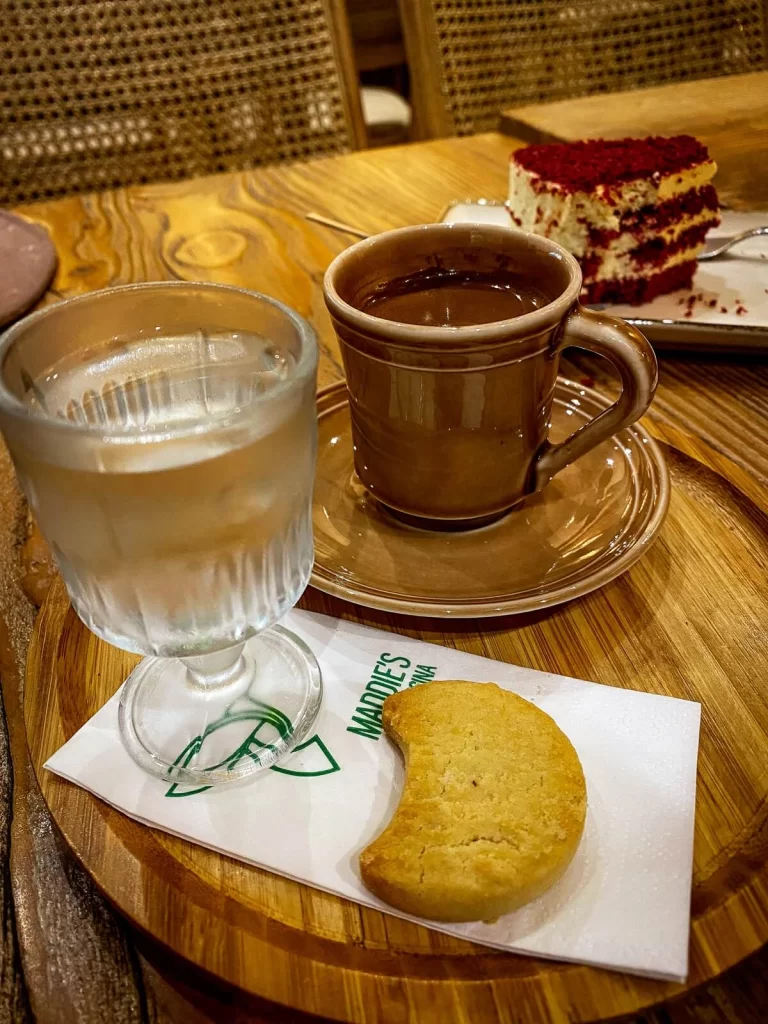

Turkish Coffee
Don’t think you’ll be left out if you’re more of a coffee than a tea drinker. Turkish coffee is something we recommend trying during your visit too.
To make it, they boil finely ground coffee with water and sugar in a cezve, which is a small copper pot. They’d normally ask us how sweet we’d like it prepared.
You’ll get your Turkish coffee in a small porcelain cup, and it looks a bit like an espresso. However, there will be coffee grounds at the bottom. They normally give you a glass of water and a few pieces of Turkish Delight with your order too.
Top Tip. If you also want to have a go at preparing traditional Turkish coffee, then consider signing up for a coffee making workshop whilst you’re in Istanbul.
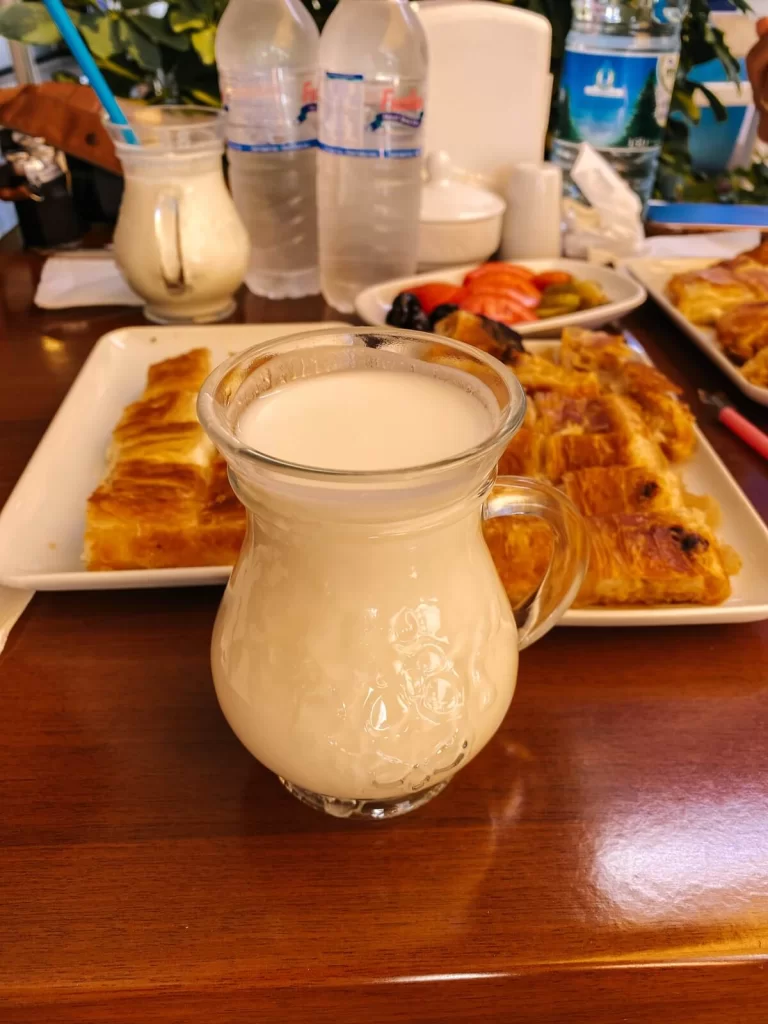

Ayran (Salty Yoghurt Drink)
Ayran is a refreshing drink we enjoyed a lot in Türkiye. It’s essentially a cold, salty yoghurt drink which Turks drink either on its own, or with their meals. Some might find it a bit too strong but to us, it tasted just like a saltier version of kefir.
Drinking ayran has a lot of health benefits. It helps to replenish the salt in your body that you’ve sweated out during the day, so basically works as an electrolyte. Ayran can also help with digestion, which is why most people consume it during their meal.
We sometimes bought ayran in the convenience stores, in the form of a yoghurt pot. Some of the store-bought ones were definitely less salty, so you could always try those if you’re unsure whether you’ll like the taste.
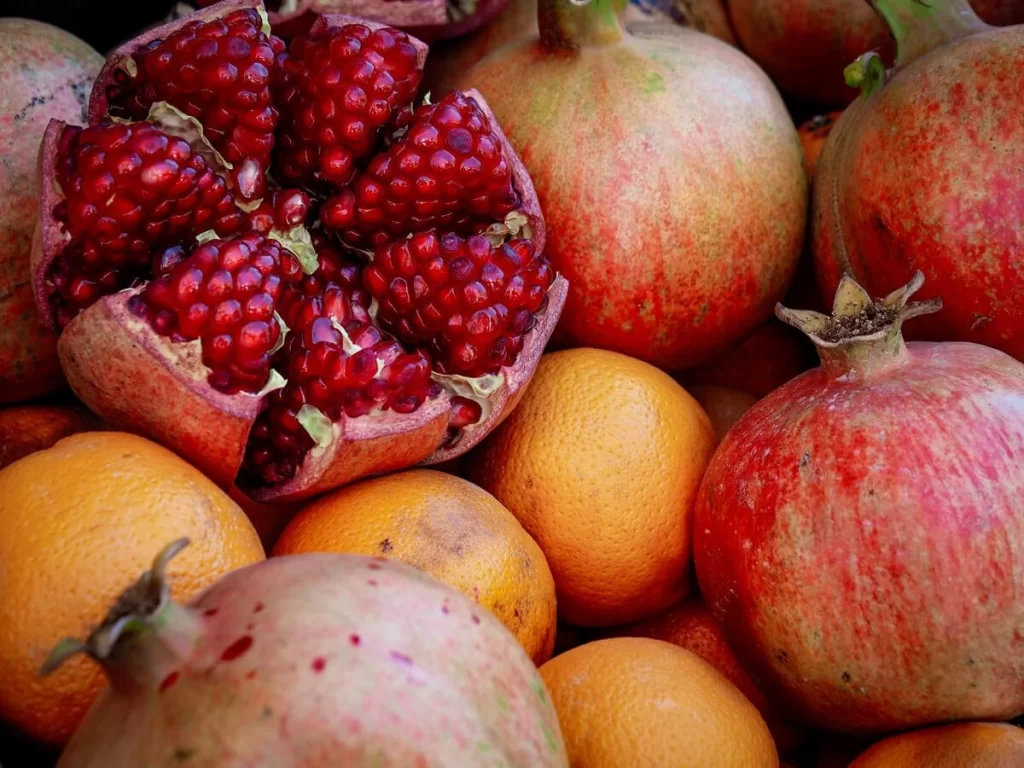
Pomegranate Juice
Fresh fruit juices are something we got used to drinking daily during our time in Mexico and Central America. So, when we learned that Türkiye is one of the largest pomegranate producers in the world, we knew that were going to drink a lot of pomegranate juice.
You’ll find fresh juice stands everywhere. They’re definitely not the cheapest, but it’s worth trying them at least once whilst in the country. It’s an especially refreshing drink during the hot summer months, and we had a few during our visit to Selcuk and the ancient city of Ephesus.
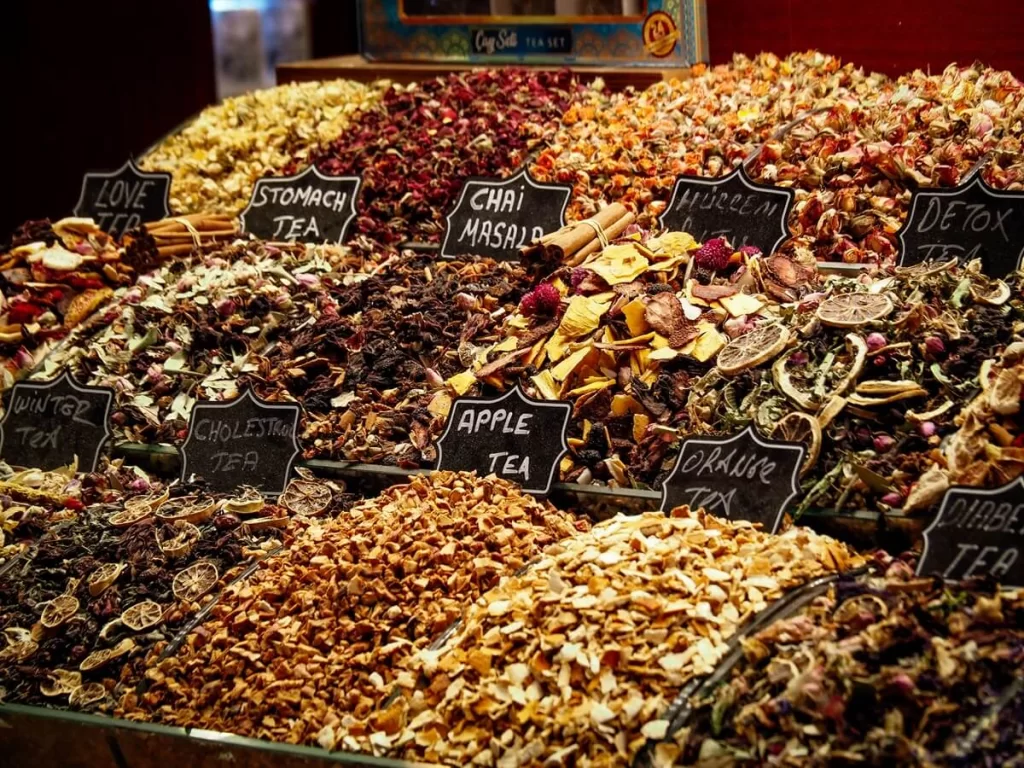
Final Thoughts on Vegetarian Turkish Food to Try
Even though we had a basic knowledge of Turkish food before arriving in the country, we were truly surprised by the variety of vegetarian dishes we could eat during our stay. As we mentioned above, we didn’t have any problems tasting the traditional flavours of Türkiye because a lot of their cuisine is vegetarian friendly.
Have you ever tried Turkish food before? If so, which was your favourite? If not, which ones from our list would you want to try during your visit? Let us know in the comments below.
Now, let your adventure begin,

Our Top Travel Resources
Accommodation: For hotels we always use Booking.com and Hostelworld for hostels. We also book longer stays on Airbnb or Vrbo.
Flights: To find the best flight prices we always check Skyscanner, Google Flights or WayAway. Then we also check the airlines’ websites too for comparison.
Car Rentals: We use Discover Cars when we want to rent a car as it compares local, national and international companies.
Activities: If we book organised tours we always check either GetYourGuide or Viator.
Foreign Currency: Whenever we can we prefer to pay in local currency and for that we always use our Wise card. We can easily withdraw money from the ATM or pay by card at most shops and restaurants.
Travel Insurance: We never go anywhere without travel insurance. You never know what will happen on your trip, so good travel insurance like SafetyWing can protect you in case of injury, illness, theft and cancellations.
eSIM and VPN: To get data abroad we use Airalo which is an app that allows you to download a prepaid eSIM to your phone in over 190 countries. Make sure to have a VPN to avoid hackers accessing your personal data when using public WIFI. We use Surfshark which is the only VPN that offers one account on unlimited devices.


